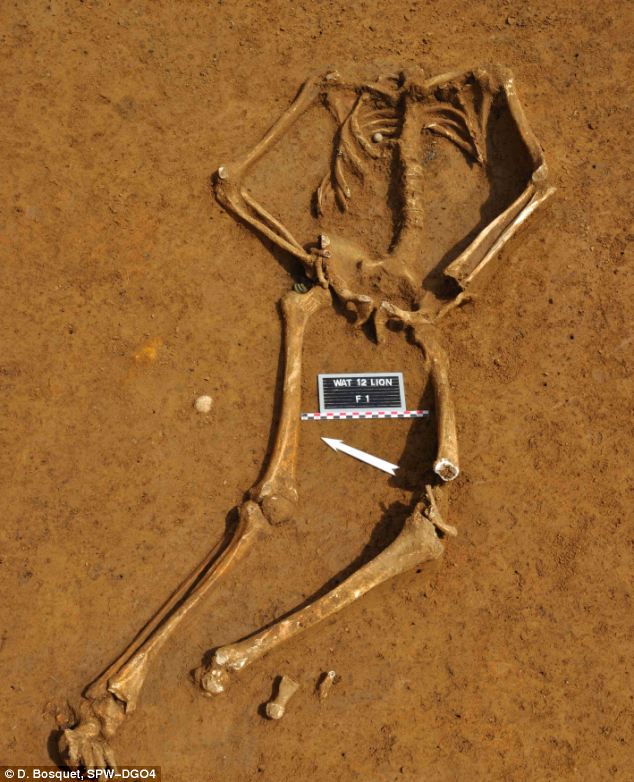Nearly two centuries later, archaeologists have unearthed the remains of the soldier – with the musket ball that felled him still lodged between his ribs.
Historians believe he is from one of the Duke of Wellington’s British regiments, and describe the discovery of the skeleton as one of the best war finds ever.

Amazing discovery: The almost complete skeleton, found buried on land the British held, is believed to be a 20-year-old soldier from one of the Duke of Wellington’s regiments who died during the Battle of Waterloo.

Cause of death: A musket ball in the soldier’s rib cage is believed to have felled him on June 18, 1815.
They are now hoping that the thick Belgian mud has preserved his personal items well enough to help them identify him.
Archaeologists have uncovered a regimental spoon, a piece of decorated leather from his uniform, coins, and a piece of wood, possibly a rifle butt, inscribed with the initials ‘C B’.
Analysis of the items could lead them to the army, regiment, and even the name of the fallen hero.
Belgian archaeologist Dominique Bosquet said: ‘The remains were found behind the British lines close to the infirmary, which makes the soldier most likely British.
‘The position where the skeleton was found would make it very difficult for it to be from a French soldier. A musket ball was found inside the rib cage. This was probably the cause of death – a gunshot wound to the chest.
‘We believe that after he was injured he was carried back from the line, and that is where he died.’

Clue: The initials C.B. carved into a nearby piece of wood – possibly a rifle butt – may help reveal his identity.

Possessions: Some coins found near the skeleton’s remains might also assist archaeologists in identifying him.

Preserved: A large spoon was also discovered lying next to the engraved piece of wood.
The skeleton came to light as Belgium prepares for the 200th anniversary of the battle that ended the reign of Napoleon Bonaparte and France’s domination of Europe.
The remains were unearthed during the excavation of plots of land for a car park close to the Lion Mound monument, near the hamlet of Mont Saint-Jean.
Unfortunately, the skull was crushed by the mechanical digger before the remains became visible.
Nevertheless, the skeleton is still one of the best-preserved from the battle, although it is missing a foot and some small hand bones.
Early analysis suggests the remains are of a 20-year-old man, standing at 5ft 1in tall, with teeth worn by biting open gunpowder tubes.
While most of the British casualties were buried at a cemetery in Evere, near Brussels, many were left where they fell. Yves Van Der Cruysen, director of the Battle of Waterloo Association, stated, “This is a major discovery. It is the first time in over a hundred years that a complete corpse of a combatant from the time has been discovered in such a good state.
The body clearly has not been robbed, as we found money on him, including a half-franc coin from 1811. There were also other coins which we are having analyzed. He could have been buried by a comrade or simply missed when the bodies were gathered up after the battle for burial.”
“We hope to find evidence of his regiment from the spoon and the leather epaulets that were found with the corpse. And we know the names of the combatants thanks to military records of the time.
When the soldier’s regiment can be determined, we should be able to find his identity.”
The Battle of Waterloo, which took place on June 18, 1815, unfolded in a sprawling field about ten miles south of Brussels. The conflict was between France and the Allied armies of British, German, Dutch, and Belgian soldiers under the command of the Duke of Wellington and General Blucher of Prussia.
The French defeat brought to a close 23 years of war that had commenced with the French Revolutionary Wars in 1792 and continued with the Napoleonic Wars from 1803.